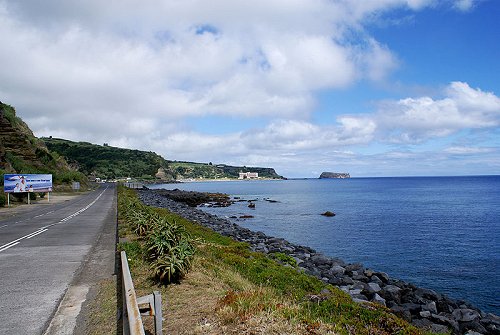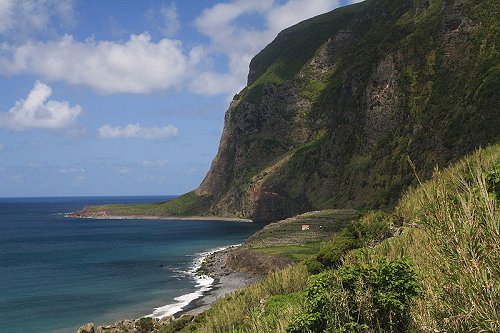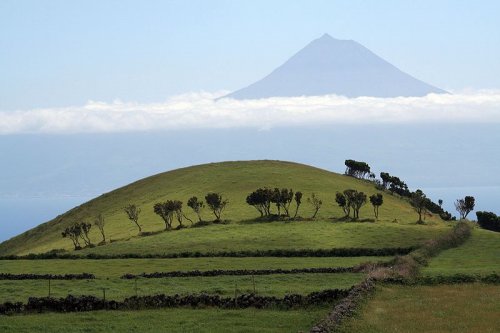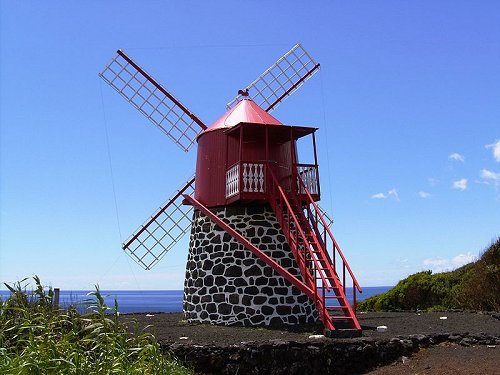
View at São Miguel Island, the Azores
Source: https://commons.wikimedia.org/wiki/File:Ostriv_S%C3%A3o_Miguel_panorama.jpg
Author: Koshelyev

The Azores is an archipelago in the North Atlantic Ocean. It comprises nine volcanic islands located some 1,500 km (930 mi) to the west of Lisbon and 3,900 km (2,400 mi) to the east of the coast of North America. The Azores is an autonomous region of Portugal similar with Madeira.

Praia dos Trinta Reis, São Miguel Island
Source: https://commons.wikimedia.org/wiki/File:Praia_dos_Trinta_Reis_com_o_ilh%C3%A9u_de_Vila_Franca_ao_fundo,_%C3%81gua_de_Alto,_ilha_de_S%C3%A3o_Miguel,_A%C3%A7ores.JPG
Author: Luissilveira

The archipelago of the Azores extend some 600 km (370 mi) from northwest to southeast. The islands have a total land area of 2,346 sq km (906 sq mi). The islands forming the archipelago are Corvo, Faial, Flores, Graciosa, Pico, São Jorge, São Miguel, Santa Maria and Terceira. The functions of the capital are shared between three towns, Angra do Heroísmo, Horta and Ponta Delgada. The highest mountain in the Azores is the 2,351-meter (7,713 ft) Mount Pico, on the island of Pico. If measured from the ocean floor, then many of the mountains in the Azores are the tallest on the planet.
The discovery and settlement of the Azores began in a similar fashion with Madeira. Earliest maps showing the existence of the Azores date back to 1351. The island was officially discovered in 1431 by Gonçalo Velho Cabral, although explorer Diogo de Silves is also credited with its discovery in 1427. Following the discovery, and finding that there were no large animals on the island, sheep were brought over. Settlement did not begin immediately, as there was little appeal in living on an isolated archipelago.

Fajã de Lopo Vaz, Flores, the Azores
Source: https://commons.wikimedia.org/wiki/File:Azoren_Flores_Faja_de_Lopo_Vaz.jpg
Author: Dreigung

In the later part of the 15th century, African slaves were brought to the island of São Miguel and abandoned there to fend for themselves. Then more domesticated animals were brought over, and villages were established.
During the Second World War, the Portuguese dictator António de Oliveira Salazar leased bases in the Azores to the British. The base enabled the Allies to effectively hunt U-boats and protect Trans-Atlantic convoys. After the war, the Americans continued to maintain a base there to patrol the North Atlantic Ocean for Soviet submarines and spy vessels. The Azores was also the venue of a summit between US President George W. Bush, British Prime Minister Tony Blair, Spanish Prime Minister José María Aznar and Portuguese Prime Minister José Manuel Durão Barroso, just before the start of the Iraq War.
Today the people of the Azores, called the Azoreans, have developed their own distinct identity and cultural traits. They hold religious festivals and celebrate feast days of their patron saints.

Mount Pico, as seen from São Jorge, the Azores
Source: https://commons.wikimedia.org/wiki/File:Azoren_%2814%29.jpg
Author: Björn Ehrlich

Going to the Azores
The Ponta Delgada Airport (PDL) is the main gateway to the Azores. TAP, the Portuguese flag carrier, has regular services to Ponta Delgada from Lisbon and Funchal. Other airlines flying there include Azores Express and SATA Azores.To explore the Azores, it is most practical to rent a car. Then you will be able to visit some of the remote areas. The terrain in some places is steep and rugged, so proper vehicle is necessary. If you have the time, then cycling is another possible option, though you should expect to push your bike up some hill slopes.

Mistério de São Jaão windmill, Pico Island, the Azores, the Azores
Source: https://commons.wikimedia.org/wiki/File:Moinho_pico_1.JPG
Author: Carlos Luis M C da Cruz

Islands of the Azores
- Corvo
- Faial
- Flores
- Graciosa
- Pico
- São Jorge
- São Miguel
- Santa Maria
- Terceira
Towns in the Azores
- Angra do Heroísmo - seat of the judiciary
- Horta - seat of legislature
- Ponta Delgada - seat of presidency
- Lagoa
- Lajes das Flores
- Lajes do Pico
- Madalena
- Nordeste
- Povoação
- Praia da Vitória
- Ribeira Grande
- Santa Cruz da Graciosa
- Santa Cruz das Flores
- São Roque
- Vila do Corvo
- Vila do Porto
- Vila Franca do Campo
 Latest updates on Penang Travel Tips
Latest updates on Penang Travel Tips

Copyright © 2003-2025 Timothy Tye. All Rights Reserved.

 Go Back
Go Back